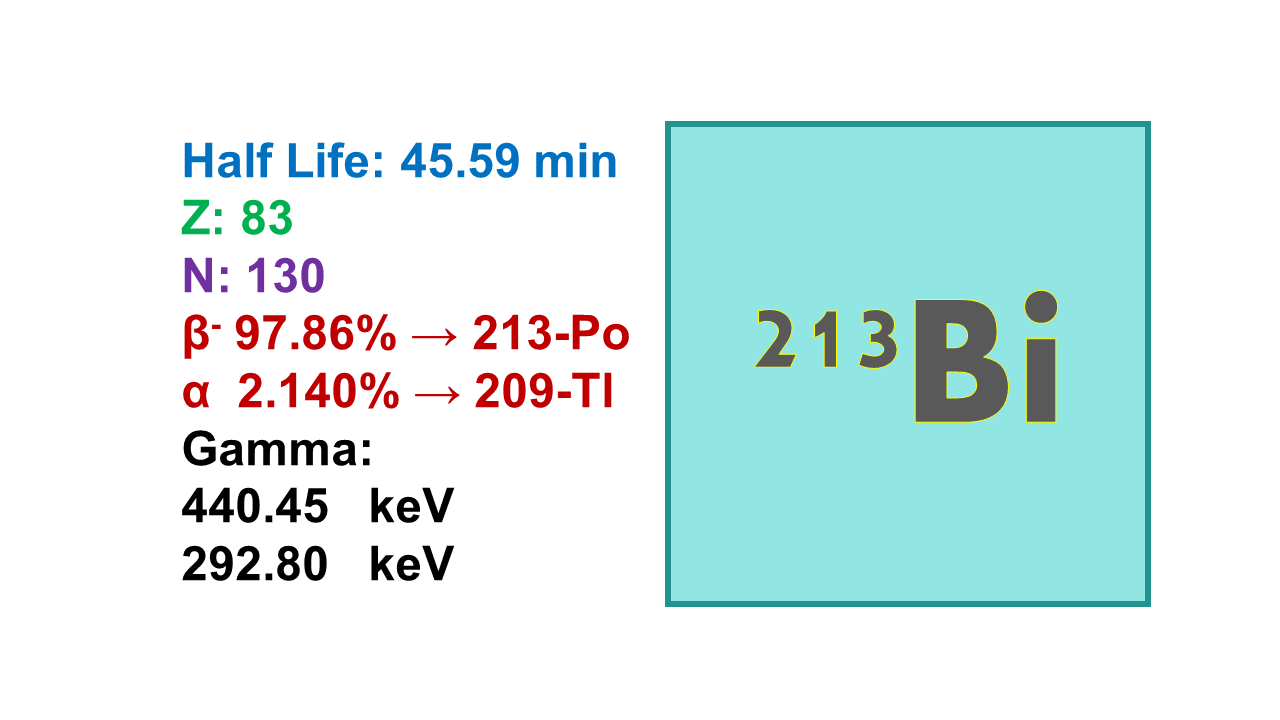
Bismuth-213 (213Bi)
January 11, 2024
Properties:
Bismuth-213 (213Bi) is an alpha emitter with a short half-life of 45.6 min.
◼ 213Bi decays into Thallium-209 (209Tl, 2%) and Polonium-213 (213Po, 98%) with emission of α (5,869 keV, 93%; 5,549 keV, 7%), β– (1,427 keV, 65%; 987 keV, 30%) and γ rays (440 keV, 26%).
◼ Both 209Tl (half-life of 2.2min; 100% β–, 1,832 keV, but also γ, 100% at 1,567 keV and 99% at 465 keV) and 213Po (half-life of 4.2 µs; 100% α, 8,376 keV) decays into 209Pb (half-life of 3.25 h; 100% β–, 644 keV) which transforms into stable 209Bi.
Toxicity: unbound 213Bi accumulates in kidney.
Manufacturing:
As 213Bi is a decay product of 225Ac, it is easy to produce this radionuclide from a 225Ac/213Bi generator. However, as the demand is very low, only rare manufacturing centers are able to offer this service.
A standard 225Ac/213Bi generator (740-1036 MBq – 20-30 mCi) can produce up to 6 therapeutic doses of 25 mCi 213Bi per day. Two hours after elution of a generator, 83% of the maximum activity has grown back and 93% after 3 hours.
Source and availability:
Actinium-225/Bismuth-213 Generator.
Derivatives:
213Bi is used for targeted alpha therapy, especially in treatments of cancers, including leukemia. For the alpha-labeled Bismab-B (213Bi-CHX-A”-DTPA-huM195, 213BiLintuzumab), doses used in patients remain quite high (1 mCi/kg up to 100 mCi/patient) for an alpha emitter. Next to Bismab-B, 213Bi has been used in trials performed in Europe and Australia and targeted 213Bi against lymphoma, progressive glioma, and melanoma is being investigated. In the course of the development of the ABY-025 family for imaging (111In, 68Ga) and treatment of metastasized breast cancer, Affibody recently recommended the use of 213Bi rather than 211At (excretion of 211At being too fast).
The first human data obtained with 213Bi-PSMA-617 (2017)49 showed also a great efficacy which was attributed to the concomitant emission of alphas and betas by 213Bi, compared to 177Lu.
Additional drugs that have been explored as 213Bi-labeled compounds include 213Bi-antiCD20-mAb, 213Bi-9.2.27mAb, 213Bi-Substance-P, 213Bi-8C3, 213Bi-DTPA-PAN-622 or 213BiDOTATOC.
Price:
The price of the generator remains quite high for the time being as generators are only produced occasionally. Depending upon the dose, the price of generators lies between EUR 20,000 and EUR 40,000 (US$ 26,000 and US$ 52,000).
Issues:
◼ Sources of the precursor are limited and as a consequence, manufacturers of generators are rare and prices will remain high.
◼ Only limited information of advantages over other alpha-emitters is available and the fact that it is a generator-produced radionuclide is not necessarily an advantage.
Comments:
This radionuclide was used to label the first antibodies with alpha emitters until it became obvious that the parent alpha emitter 225Ac was easier to handle. It was initially developed because it provides a unique solution of an alpha emitter produced via a generator that could be available at the patient’s bed. As such it was used to label huM195 (213Bi-Bismab-A) and went through a few clinical trials mainly in AML. There is an advantage in the decay chain of 213Bi which is cleaner compared to 225Ac, but this radionuclide still does not directly decay into a stable isotope. However, additional advantage resides in the concomitant emission of beta and alpha rays.